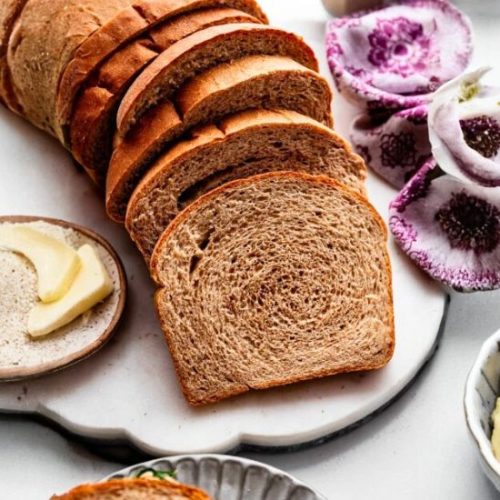
Soft and Hearty Whole Wheat Bread
This soft and hearty Whole Wheat Bread isn’t just a delicious homemade alternative to store-bought loaves—it’s a nutritional powerhouse and a satisfying staple you’ll return to again and again
Equipment
- 1 Stand Mixer (with dough hook attachment) or 1 Large Mixing Bowl and 1 Wooden Spoon
- 1 9×5-Inch Loaf Pan
- 1 Instant-Read Thermometer
- 1 Rolling Pin
- 1 Pastry Brush
- 1 Wire Cooling Rack
- 1 Measuring Cup Set + Measuring Spoon Set
Ingredients
For the Sponge Starter:
- 1 cup 240 ml warm water (about 110°F / 43°C)
- ⅓ cup 80 ml warm whole milk (about 110°F / 43°C)
- 2¼ teaspoons 7 g active dry or instant yeast (1 standard packet)
- 2 cups 260 g whole wheat flour, spooned and leveled
For the Dough:
- 3 tablespoons 63 g honey
- 3 tablespoons 43 g unsalted butter, softened
- 1 teaspoon lemon juice or apple cider vinegar
- 1⅓ cups 173 g whole wheat flour, spooned and leveled (plus extra as needed)
- 1¼ teaspoons salt
Optional Topping:
- 1 egg white lightly beaten
- 1 tablespoon whole oats
Instructions
- Make the Sponge Base: In a large mixing bowl or the bowl of your stand mixer, combine warm water, warm milk, and yeast. Stir in 2 cups of whole wheat flour until you form a thick, sticky batter. Cover the bowl loosely with a towel or plastic wrap and let the sponge rest at room temperature until it becomes puffy and doubled in size—this typically takes 1 to 1.5 hours, though it can take up to 2 hours depending on conditions.
- Form the Dough: Once the sponge has risen, add honey, softened butter, lemon juice, remaining 1⅓ cups of flour, and salt to the bowl. Using a dough hook on medium speed (or a sturdy spoon and strong arm), mix until the dough pulls away from the sides of the bowl and forms a ball—about 3 minutes. If the dough is too wet or loose to handle, gradually mix in more flour, one tablespoon at a time, just until the dough becomes manageable and only slightly sticky.
- Knead Until Smooth: Continue kneading the dough for 8 to 10 minutes—either with your stand mixer on low-medium speed or by hand on a lightly floured surface. The dough should become soft and elastic but not dry. It should slightly stick to your fingers but pull away cleanly when gently poked.
- Let the Dough Rise: Transfer the kneaded dough to a greased bowl, turning it once to lightly coat all sides with oil. Cover and place in a warm area to rise until doubled in size—about 1.5 to 2 hours.
- Shape the Loaf: After the first rise, gently punch down the dough to release built-up air. On a lightly floured surface, roll it out into a rough rectangle (about 8×15 inches). Starting from one short end, roll it up tightly into a log, tucking in the ends if needed. Place the shaped loaf into a greased 9×5-inch pan, seam side down.
- Final Rise: Cover the loaf and let it rise again until it peaks about 1 inch above the rim of the pan. This second rise usually takes 45 to 60 minutes.
- Prepare to Bake: Position your oven rack to the lower third of the oven and preheat to 350°F (177°C). If adding the oat topping, gently brush the top of the risen loaf with beaten egg white and sprinkle oats on top just before baking.
- Bake to Perfection: Place the pan in the oven and bake for 36 to 40 minutes, or until the top is golden brown. If it begins to darken too quickly, loosely cover it with foil around the 20-minute mark. The loaf is fully baked when it sounds hollow when tapped or when a thermometer inserted into the center reads 195–200°F (90–93°C).
- Cool and Slice: Let the bread cool in the pan for 10 minutes before transferring it to a wire rack to cool completely. Slice when fully cooled or slightly warm, if preferred.
Notes
Freezing Instructions: To freeze before baking: Prepare the loaf through the shaping stage (Step 5), place in a greased or disposable loaf pan, cover tightly, and freeze for up to 3 months. When ready to bake, thaw and let it rise at room temperature for 4–5 hours, then bake as directed.
To freeze after baking: Let the bread cool completely, then wrap well and freeze for up to 3 months. Thaw at room temperature or in the fridge before reheating or toasting.
Overnight Prep Options:
For a longer fermentation:
For a longer fermentation:
- Option 1: Shape the loaf, cover, and refrigerate overnight (Step 6). Allow to rest at room temperature for 1–2 hours the next day before baking.
- Option 2: Refrigerate after kneading (Step 3), then let rise at room temperature for 2 hours before shaping and continuing.